

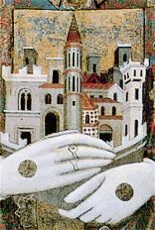
The illustration above, which is a detail of a panel (ca. 1330) by the Maestro dei Dossali di Montelabate that is now in the Galleria Nazionale, is the only surviving image of the episcopal complex of Perugia before the construction of the present Duomo.
According to a hagiographic tradition that probably developed over the 12th and 13th centuries, Bishop Rogerio translated the relics of St Herculanus from San Pietro to “ecclesesia beati Laurencij”. According to local historians, this bishop was documented in 936. Scholars are broadly agreed that the old Duomo stood on the site of the left transept of the present church, and that it was within a fortified structure known as the Castello di San Lorenzo.
Few primary sources survive for the early history of the complex: most of these refer to series of disputes between the bishop and the Canons of San Lorenzo from their formation as a clerical community in 1033.
In 1163, during his war with Pope Alexander III, the Emperor Frederick I took Bishop John IV and the Canons of San Lorenzo under imperial protection and confirmed all of their possessions. The surviving copy of this privilege does not mention the relevant pope, but this was presumably the anti-pope Victor IV. Local tradition has it that a subsequent anti-pope, Callistus III (1168-77) consecrated the high altar of the Duomo. However, Alexander III also confirmed the possessions of the canons’ possessions in 1169. It is likely that this was a period of schism within the episcopal authorities of Perugia: apart from this mention of John IV, no bishop is documented between 1160 and 1179. However, any un-canonical situation regarding the consecration of the Duomo was corrected when Pope Innocent III re-consecrated it during his stay in Perugia in 1198.
In 1300, the leading citizens of Perugia took the momentous decision to build a new Duomo and Bishop Francesco Graziani laid the foundation stone in 1345. In 1373-5, the papal legate Gérard du Puy, Abbot of Marmoutier, (known to the Italians as “Monmaggiore”) raided the construction site for building material for his new Fortezza di Porta Sole. He also demolished the ancient campanile (below) in order to make way for corridor that linked his new fortress to the Palazzo dei Priori.
Work on the new church restarted after he had been driven out of the city in the rebellion of 1375. The original church was then progressively subsumed by its successor.
Original Campanile (9th century ?)
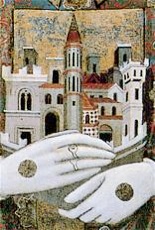
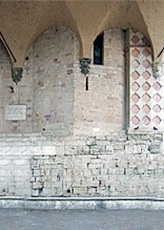
The illustration above, which is a detail of a panel (ca. 1330) by the Maestro dei Dossali di Montelabate that is now in the Galleria Nazionale, is the only surviving image of this original 12-sided campanile, which was built above a stretch of wall that had probably terraced the Roman forum. Vestiges of it survive under the Loggia di Braccio (see also the page on the exterior of the present church). According to a 14th century tradition, Ulysses had buried the palladium of Troy here, having brought it to Perugia after the fall of that city. (This sacred image of Pallas Athena had protected Troy until Ulysses had managed to steal it. A similar legend had Aeneas taking it to Rome).
The campanile was probably built originally to defend the adjacent episcopal enclave. From the 12th century, it provided the locus for the secular government of the city. For example:
-
✴It was in the shadow of the campanile that the twelve consuls of the newly formed Commune accepted the submission of the people of Isola Polvese in 1139, thereby formalising the earliest recorded act of Perugian colonisation.
-
✴In 1234, the Petra Justitiae (Stone of Justice) was set into its walls. The inscription recorded the terms of a settlement that was reached between the nobles and the Popolo of Perugia after a long civil war. A copy now marks the original location: the original inscription, which was carved on marble from a Roman building (1st century AD), is now in the Sala del Consiglio of the Palazzo dei Priori.
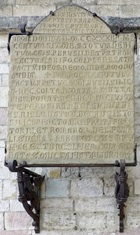
-
✴In 1309, on the feast of St Herculanus, the Priors of Perugia received the formal acts of submission of all the subject territories at the foot of the campanile.
Chapel or Altar of St Herculanus
In 1216, Innocent III consecrated an altar in the Duomo that was dedicated to St Herculanus. When he died shortly afterwards, he was buried near this altar.
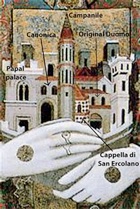
However, Attilio Bartoli Langeli and Maria Rita Silvestrelli (referenced below) point out that the architecture of the chapel in this painting does not suggest a building that existed in 1216. They suggest that this was in fact the Cappella di San Giovanni Battista, which the Commune decided to build near the campanile after their victory against Todi at the Battle of Montemolino (1310), and which was completed in ca. 1326. Its facing obviously inspired that of what is now the left wall of the present church (see the page on the exterior of the present church).
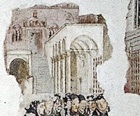
Papal Monuments in the Old Duomo
The old Duomo contained the tombs of three 13th century popes:
-
✴As noted above, Innocent III died in Perugia in 1216 and was buried near the altar dedicated to St Herculanus. Nothing is known about his monument.
-
✴Pope Urban IV died in Perugia in 1264. The city statutes of 1279 imposed fines on those damaging the monument during clashes between the Guelfs and Ghibellines of the city.
-
✴Pope Martin IV died in Perugia in 1285. He had wished to be buried at San Francesco, Assisi but the Perugian authorities ignored this. They commissioned Fra. Bevignate to oversee the construction of his monument in 1287: it is possible that is remains were placed in it in 1295. In the following year, the newly elected Pope Boniface VIII objected to the monument's location and the canons duly moved it to a more prestigious position (presumably near the high altar).
According to Giorgio Vasari, “Urban IV having died ... in Perugia, a summons was sent to Giovanni [Pisano], who, having gone there, made a tomb of marble for that Pontiff, which, together with that of Martin IV, was afterwards thrown to the ground when the people of Perugia enlarged their Vescovado [Episcopal Palace], in a manner that there are seen only a few fragments of it scattered throughout the church”. In fact, Urban IV died in 1264, some 10 years before the first recorded work by Giovanni Pisano. It is possible, however, that he worked on the monument to Martin IV (died 1285).
All of these monuments were subsequently destroyed, although Giorgio Vasari reported that a few fragments from them were scattered throughout the later church.
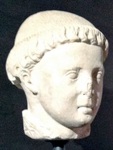
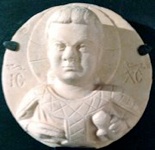
-
✴Two fragments by a follower of Arnolfo di Cambio that are now exhibited in the Museo Capitolare might have belonged to the monument to Urban IV. They depict:
-
•the head of a deacon; and
-
•a tondo of Christ the Redeemer.
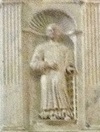

-
✴The reliefs of SS Lawrence and Herculanus reused on the pulpits (1519) in the present church might have belonged to the monument to Martin IV, in which case they could be by Giovanni Pisano.
All three popes are now commemorated in the Papal Mausoleum (1615) of the present church.
Other Art from the Old Duomo
Relief (12th century)
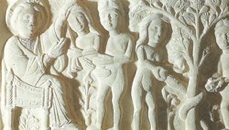
This relief, which was part of a frieze on that depicted scenes from Genesis, came from the an altar on a pilaster in the old Duomo that subsequently became known as the Altare della Madonna del Verde (see below). The surviving scenes, which are now in the Museo Capitolare (Room 12-13), depict:
-
✴God blessing Eve as she emerges from Adam's side; and
-
✴Adam and Eve standing below the tree of the forbidden fruit.
Madonna del Verde (early 14th century)

The fresco, which has been heavily repainted, was transferred to canvas in 1466. The heirs of the merchant Nicolò Bucci commissioned the new Altare della Madonna del Verde to house it in the right aisle of the present church. They simultaneously commissioned a Pietà and panels of eight angels from Bartolomeo Caporali, and it has been assumed that these were to be incorporated into the altar. Unfortunately, they have been lost.
-
✴The altar was dismantled in 1849 and later re-erected in the baptistery.
-
✴The altarpiece was moved to Sant' Angelo at that point, and moved again to the Museo Capitolare. It was replaced in Sant’ Angelo by a copy.
Read more:
L. Cagni, “Sotto la Cattedrale: Scoperte e Riflessioni a Seguito dei Lavori di Consolidamento della Cattedrale di Perugia”, (2009) Foligno
A. Bartoli Langeli and M. Silvestrelli, “Il Comune Duecentesco e i Suoi Palazzi”, in
F. Mancini (Ed), “Il Palazzo dei Priori di Perugia”, (2000) Perugia, pp 3-12
E. Lunghi, “Perugia: la Cattedrale di San Lorenzo”, (1994) Perugia
Duomo: Main page Earlier Church Exterior Interior Chapels.
Return to Monuments of Perugia

